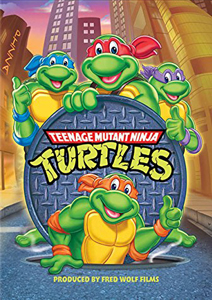The five-episode first season of the “Teenage Mutant Ninja Turtles” cartoon (1987) launched a 10-season, 193-episode series – one that’s generally thought of as being the, well, cartoony branch of “TMNT.” But rewatching the five episodes makes me realize they heavily influenced the 1990 film and introduced many things we now consider standard “TMNT” elements across all continuities.
Inventing now-familiar elements
Series developer and lead writer David Wise (assisted by wife and co-writer Patti Howeth) bridged the gap between the Mirage comics, which launched in 1984, and the 1990 movie. According to Andrew Farago’s “TMNT: The Ultimate Visual History” (2014), Wise – a fan of the comics before he got the gig – came up with the idea of distinct personalities and mask colors.
Granted, Kevin Eastman and Peter Laird had given Leo, Raph, Mike and Don personalities in the Original 16 comics (Issues 1-11 and five one-shots) that were out by the time Wise was tasked with bringing the Turtles (and the accompanying Playmates toys) to children.

“Teenage Mutant Ninja Turtles” Season 1 (1987)
Five episodes, syndicated
Episodes: “Turtle Tracks,” “Enter the Shredder,” “A Thing About Rats,” “Hot Rodding Teenagers from Dimension X,” “Shredded and Splintered”
Developed by: David Wise
Director: Yoshikatsu Kasai
Writers: David Wise, Patti Howeth
But Wise – assisted by a game voice cast — made them sharper, as the theme song’s lyrics underline. Most notably distinct from the comics, Raphael is sarcastic but not angry. The 1990 movie aimed for both kids and adults and could afford to make Raph angry again, so the wisecracking, movie-quoting aspect of cartoon Raph was incorporated into the movie Michaelangelo.
These five episodes – “Turtle Tracks,” “Enter the Shredder,” “A Thing About Rats,” “Hot Rodding Teenagers from Dimension X” and “Shredded and Splintered” (officially “Shredder and Splintered,” but I choose to not use the typo-marred title) – take the plot from the Original 16 comics. The broad narrative would be adapted for the movie by Bobby Herbeck and Todd W. Langen and for the Nintendo games (particularly II, III and IV, where the Technodrome features heavily).
The Turtles meet April (a reporter, not a lab assistant) for the first time by rescuing her from her attackers. April and the Turtles investigate the Foot Clan’s crime wave through New York City. The Turtles eat pizza. They encounter a whole host of Foot Soldiers on a rooftop. They cause minor mischief at the apartment of a flustered April. They meet Shredder and make fun of his blade-covered outfit. Splinter and Shredder square off and discuss their rivalry. The Turtles eat more pizza.
Drawing from pop culture
Wise, who died in 2020, clearly absorbed a lot of movies and TV; this is a nice parallel to how Eastman and Laird riffed on their favorite comics (namely “Daredevil,” in Issue 1). The “Star Wars” element of Splinter vs. Shredder (Obi-Wan vs. Darth Vader) is blunt, as is the “Frankenstein” nod when Shredder puts Krang (patterned on Mirage’s Utrom aliens) into his android body. Raph drops pop-culture references almost every time he speaks, from the obvious (“Where’s Godzilla when you need him?”) to the subtle. “I’d recognize that wad of chewing gum anywhere!” is like something out of “Police Squad!”

The scripts and animation are free-wheeling, winking, and clearly cranked out – but in a way that’s energetic and propulsive. It’s hilarious when Splinter glowers at April to cap his origin story and grandly announces as if he has a much wider audience: “And that’s how they became … the Teenage Mutant Ninja Turtles!” (The capitalizations are very much Splinter’s.)
The plot is a loose (and convenient, as Shredder and Krang could crush the Turtles if they didn’t bicker over the how and when) foundation on which quips can be added, setting the series’ formula as a light parody of everything. But also, this arc was adapted for Archie Comics’ “TMNT Adventures,” and that series shifted in yet another direction. It focused on nature and conservancy issues, befitting the Turtles’ animal sides and also allowing for more mutants.
So in one week in December 1987, Wise essentially launched five branches of kid-targeted continuity: the cartoon itself, plus the movie series, the kids’ comics, the Nintendo games and the Playmates toy line (which had its own unique narrative, as chronicled on the card backs for each character).
But the cartoon didn’t ruin the adult-aimed Turtles. Over at Mirage, Eastman and Laird (and their many friends) continued to tell gritty and arty “TMNT” stories. Meanwhile, the kid-friendly version subsidized the adult stories via pop-culture capital. All seven movies and all five TV series have been kid-aimed, but adult stories are still going at IDW Comics. (Mind you, that isn’t to say an adult-aimed film or TV series wouldn’t be welcome.)
Smart streamlining
Wise purposely launched the widely popular version of the Turtles, yet his instances of story and character streamlining are smart. Hamato Yoshi is Splinter, leading to the poignant notion that “Perhaps it is my karma to live life as a rat” and a conundrum wherein Shredder’s retro-mutagen ray gun is a boon for Splinter but terrifying for the Turtles (“We’d be turned back into – gulp – ordinary turtles!,” Donatello realizes).
As such, either animals or humans can be mutated into human-animal hybrids. This moves “TMNT” closer to the “X-Men” notion of mutants – humans who have a trait that makes them an outcast. Baxter Stockman – and his mousers, taken from Issue 2 of the comic – enters in “A Thing About Rats” as a human. In Season 2, in an unapologetic ripoff of the 1986 film “The Fly,” Baxter becomes a mutant fly. (It is rather remarkable that “TMNT” never got sued. Thank goodness for the “parody” clause.)
The series’ first bad-guy mutants are Rocksteady and Bebop, who start off as human henchmen. The former is much meaner than the sympathetic doofus he’d later become, while the latter delivers vicious lines like “Get ready for a pounding” and nearly wrings Splinter’s neck.
Building the cartoon (and toy) world
As Donatello and the Technodrome’s off-screen lab workers build Playmates toys, we get a feel for this oddly underpopulated NYC. The animation is great for the low budget and quick turnaround — although, yes, there are regular instances of one Turtle’s voice coming out of another’s mouth. And yes, we can see how much better it could be by observing the animation backing the opening theme song.
Crowd scenes don’t come out of low budgets, even in animation. But that’s OK. For introverts, the idea of a comfortable underground lair and the ability to traverse the city via vast empty tunnels is appealing. The smell and grime are only mentioned once by April, when she finally gets to clean up after a few days with her new friends. April’s (quite posh) apartment seems to be in an oddly quiet section of town, an aspect the film would borrow.
Season 1 has a sense of place, helped by a score that’s often foreboding and then intense or triumphant for the action scenes – something that would heavily influence the games, the first of which debuted in 1989. (More than reading the comics or watching the films, the 1987 cartoon makes me want to blow into a cartridge and fire up the ole Nintendo.)
A seventh “TMNT” movie is now in theaters, drawing yet another generation of kids. I’m biased when I say Season 1 of the 1987 cartoon is among the elite incarnations of “TMNT”-for-children (topped only by the 1990 film). But it’s an objective fact that it’s the most influential, as we notice every time Don whips up a gadget from spare parts, April files a report, or Mikey puts a good time ahead of saving the city.

